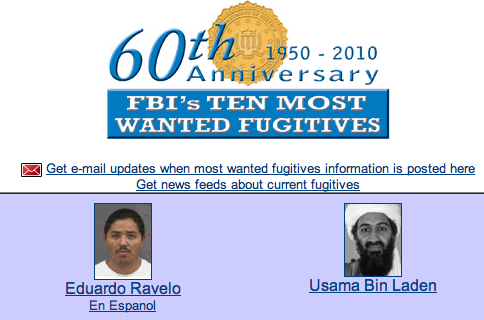Ciudad Juarez: Eduardo Ravelo is as Wanted as bin Laden
by John Murray

Eduardo Ravelo is the new ‘face of Ciudad Juarez terror,” according to the LA Times this week. This mean-looking specimen is the purported leader of the Barrio Aztecas street gang, the mostly teenage subcontractors that the Juarez drug cartel uses for the murder, kidnapping and torture of its rivals in the city. Near the end of last year, Ravelo was quietly placed on the FBI’s ten most wanted list, and a couple weeks ago, he reached a criminal pinnacle, officially supplanting Osama bin Laden as the FBI’s number one most wanted man in the world.
His sudden rise is spectacular-and there’s much competition. After all, Juarez has been the “most dangerous city in the world” since around 2007, when Mexican president Felipe Calderon began his “war on the cartels.” Home to a murder rate that topped out at almost 2700 in 2009, officials estimate that roughly 100,000 Mexican nationals have left Juarez for El Paso during the past 3 years, essentially as refugees. Is this all his doing?
Ravelo’s name is missing from just about any English-language press concerning Juarez in the past several years save for two minor occasions: when he was placed on the most wanted list at the end of 2009, and when three people affiliated with the US embassy in Juarez were murdered, allegedly by Azteca hit men, on March 15. (His name returns all of 46 Nexis mentions in a search of all English language news.) But since the embassy murders, Ravelo’s name has become more popular.
There have been, roughly, 5000 drug-related murders in Juarez between 2007 and today, and just about all of them are unsolved. But when three people associated with the US government are killed, suddenly we have Eduardo Ravelo offered up as the perpetrator, the man responsible: Juarez’s black knight.
Ravelo is exactly what the LA Times says he is: a face. In the U.S., our public sense of justice demands that a specific someone pays for affronts to our honor. That’s what’s so absurd about the reaction to the embassy employee murders. We act like a neutral party that has been drawn into a war our neighbor is fighting that doesn’t concern us, and we’re shocked. Never mind that El Paso’s sister city, sitting just inches from the land of the free, has had a higher murder rate than Baghdad for 2 years running. Forget that at $35-$45 billion a year, the drug industry is an inextricable part of the Mexican economy, totaling revenues bigger than any of its other exports, including that of oil and migrant labor combined. And of course, don’t mention that the whole reason it exists is because of the U.S. market that feeds it endlessly. Our goal, instead, is to get that guy who did this to us.
That’s essentially the nature of the war on drugs as well. The DEA doesn’t hunt out the carotid artery of the drug trade so much as it hunts images; a seizure of cocaine in Houston, a truck full of marijuana in Atlanta. We want what Commissioner Burrell from ‘The Wire’ infamously wants: “dope on the table.” We want the perception that we are doing something about it; winning battles, as a strategy of war.
The best part about Eduardo Ravelo is that he’s right there, just across the Rio Grande. As a street criminal, Ravelo makes more sense to us than institutional crime. He’s much more tangible for US authorities and the public than the real leaders of the cartels and their corrupt associates in Mexican businesses helping them stash their cash-or the government and military officials helping them move their product. He’s the perfect diversion from the unseemly notion that we could have a country to our south whose social fabric is being destroyed by the same industry that helps it stay afloat economically.
John Murray is a lover of obscurity. He lives and writes in Arizona.
